Infrastructure
Here you will find the infrastructure from all areas
AR/VR/XR
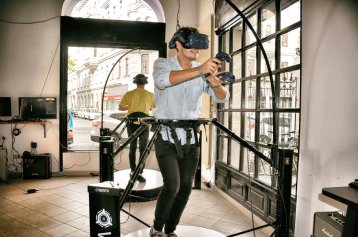 Cyberith Virtualizer in use
(Image: Cyberith Virtualizer)
Cyberith Virtualizer in use
(Image: Cyberith Virtualizer)
Cyberith Virtualizer
Cyberith Virtualizer is a fully immersive motion simulation platform for virtual reality applications. High-precision sensors are used to capture the movements, speeds, and directions of rotation of the user, which can then be transferred to a VR environment. In this way, movements such as running, jumping or squatting, among others, can be implemented in virtual worlds and these worlds can be explored in new ways. The Virtualizer can be used with the Oculus Quest 2 to make the immersive experience even more real.
Used in: FutureING AR game
Application areas: AR/VR/XR development
Contact: Prof. Dr. Anja Richert, Tobias Keller
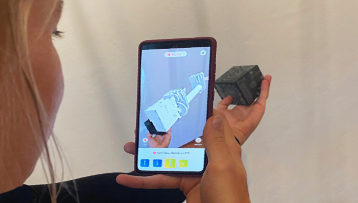 Desktop AR-Anwendung
(Image: Fakultät für Anlagen, Energie- und Maschinensysteme/THKöln)
Desktop AR-Anwendung
(Image: Fakultät für Anlagen, Energie- und Maschinensysteme/THKöln)
Desktop AR applications
Desktop AR (Augmented Reality) applications extend the perception of reality by 3D objects or information that are made visible in the environment by a smartphone or tablet. The benefits and application of AR applications are currently being researched in more detail for specific engineering science teaching scenarios (including the module Materials Application) in various master's theses. Another example is the application "AR Mechanics" in the module "Tractor Technology" by Prof. Meinel. The app for smartphone and tablet makes the functioning of a rear axle differential gear real and allows students, by extending the spatial-visual perception of the object, to visualize abstract theoretical processes as well as to interact virtually with the gearbox.
Application areas: AR/XR development
Contact: Prof. Dr. Anja Richert
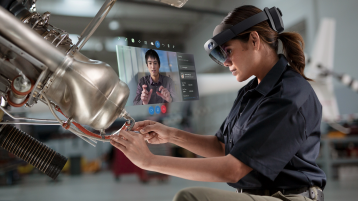 HoloLens2 Remote Assist
(Image: Microsoft)
HoloLens2 Remote Assist
(Image: Microsoft)
Microsoft HoloLens 2 (AR glasses)
Microsoft HoloLens 2 are AR glasses that allow the user to display interactive 3D projections in the immediate environment with the support of a Natural User Interface. The Microsoft HoloLens 2 can be operated via gestures, speech, head movement and small buttons. Via cameras it is possible to perceive the environment, movements and gestures. In the master's module X-Realities of the mechanical engineering program, reality is virtually extended with the HoloLens 2. 3D objects/holograms are projected into space and digital information layers or visual aids are integrated into the real world. 3D projections and immersive applications for engineering teaching with HoloLens 2 are also currently being investigated in more detail in a master's thesis.
Application areas: AR/XR development
Contact: Prof. Dr. Anja Richert, Prof. Dr. Valérie Varney, Tobias Keller
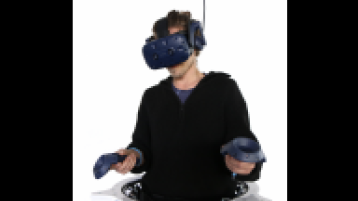 HTC Vive Pro im Einsatz
(Image: F09/TH Köln)
HTC Vive Pro im Einsatz
(Image: F09/TH Köln)
HTC Vive Pro (VR glasses)
The HTC Vive Pro is a virtual reality set that enables experiencing and working in the virtual world. Particularly noteworthy is the resolution of 2880x1600 pixels of the VR glasses. With the VR set, several people can interact with each other virtually on an area of up to 100m². Furthermore, the HTC Vive Pro can also be used in the Cyberith Virtualizer.
Application areas: VR/XR development
Contact: Prof. Dr. Anja Richert, Prof. Dr. Valérie Varney, Tobias Keller, Paul Varney
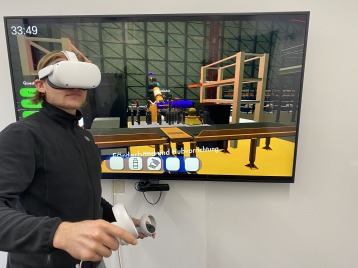 Oculus Quest 2 im Mixed-Reality Game FutureING
(Image: Cologne Cobots Lab/TH Köln)
Oculus Quest 2 im Mixed-Reality Game FutureING
(Image: Cologne Cobots Lab/TH Köln)
Oculus Quest 2 (VR Glasses)
VR (Virtual Reality) glasses allow users to immerse themselves in a digital world. This can be utilized in VR-based training, for example, which can lead to a deeper understanding through learning by doing. The Oculus Quest 2 enables immersive work in the mechanical engineering master module X-Realities. It can also be used in game-based learning settings: the mixed reality game FutureING, which is part of the bachelor module "Work techniques and project organization", is currently being expanded to include using the VR glasses.
Used In: FutureING AR game
Application areas: AR/VR/XR development
Contact: Prof. Dr. Anja Richert, Prof. Dr. Valérie Varney, Tobias Keller, Paul Varney
Development environments
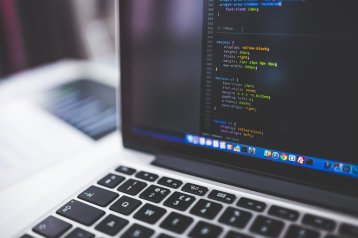 Symbolbild Laptop
(Image: Pexels)
Symbolbild Laptop
(Image: Pexels)
Working and Programming in the lab are carried out in and with various development environments. The following list shows which operating systems the lab works with and for which area the individual systems are used.
Desktop PCs
- Platform: Linux & Windows
- Application areas: AR/VR/XR development, CAD, artificial intelligence, programming, sensors, simulation & computation
Laptops
- Platform: Linux, Mac & Windows
- Application areas: Mobile working, programming, sensors, study conductions
Tablets
- Platform: Mac
- Application areas: Mobile work, study conductions
Raspberry Pi 3B+ & 4
- Platform: Linux, Octoprint, Raspbian
- Application areas: Additive manufacturing, programming, sensors
Sensors
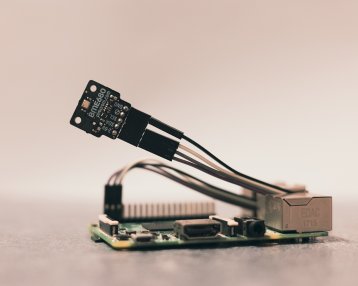 Sensorik Symbolbild
(Image: Denis Cosmin)
Sensorik Symbolbild
(Image: Denis Cosmin)
3D Lidar RoboSense RS-LiDAR-16
- Function: Three-dimensional distance measurement by means of laser
- Application areas: Mapping, navigation, simultaneous localization and mapping (SLAM)
- Research Projects: Student research projects & third-party funded projects
- Contact: Prof. Dr. Anja Richert
EDA Sensor
- Function: Measurement of skin conductance
- Application areas: Vital signs, stress response, physical/mental stress
- Research projects: MeRobot, MyRobot, Student research projects & third-party funded projects
- Contact: Prof. Dr. Anja Richert, Caterina Neef
EEG sensor
- Function: Measurement of brain activity
- Application areas: Vital signs, stress response, physical/mental stress
- Research projects: Student research projects & third-party funded projects
- Contact: Prof. Dr. Anja Richert, Caterina Neef
ECG sensor
- Function: Measurement of cardiac activity
- Application areas: Vital signs, stress response, physical/mental stress
- Research projects: MeRobot, MyRobot, Student research projects & third-party funded projects
- Contact: Prof. Dr. Anja Richert, Caterina Neef
EMG sensor
- Function: Measurement of muscle tension
- Application areas: Vital signs, stress response, physical/mental stress
- Research projects: Student research projects & third-party funded projects
- Contact: Prof. Dr. Anja Richert, Caterina Neef
Lux Sensor
- Function: Measurement of brightness
- Application areas: Experimental environments
- Research Projects: Student research projects & third-party funded projects
- Contact: Prof. Dr. Anja Richert, Caterina Neef
Microsoft Azure Kinect DK
- Function: Image processing using three-dimensional cameras
- Application areas: Body tracking, motion analysis
- Research projects: Milki-PSY, Student research projects & third-party funded projects
- Contact: Prof. Dr. Anja Richert, Tobias Keller, Nicolas Kaulen
PupilLabs Pupil Core
- Function: Eye tracking by means of two-dimensional cameras
- Application areas: Vital signs, stress response, physical/mental stress
- Research projects: MeRobot, Student research projects & third-party funded projects
- Contact: Prof. Dr. Anja Richert
Robots | Drones
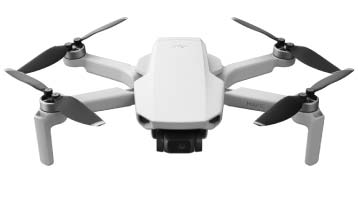 DJI Mavic Mini Drone
(Image: DJI.com)
DJI Mavic Mini Drone
(Image: DJI.com)
DJI Mavic Mini
Small drone with a total weight of less than 250 grams. Equipped with a 4K camera and a maximum flight altitude of 3,000 meters, it can produce spectacular video footage.
Specifications:
- Weight: 249 g
Dimension:
- Folded: 140 × 81 × 57 mm (L×W×H).
- Unfolded: 159 × 202 × 55 mm (L×W×H).
- Unfolded (with propellers): 245 × 289 × 55 mm (L×W×H)
Speeds:
- Max. Climbing speed: 4 m/s
- Max. Descent rate: 3 m/s
- Max. Airspeed: 13 m/s
- Max. Flight altitude: 3.000 m
- Max. range: 580 mm
- Max. Flight time: ~ 30 minutes
- Hover accuracy: +/- 0.1 m (vertical); +/- 0.3 m (horizontal)
Camera:
- Max. Resolution: 4000x3000 (4:3); 4000x2250 (16:9)
- Video: 2.7K (30 fps); FHD (60 fps)
Application areas: Virtual lab tour, movie recording
Contact: Prof. Dr. Anja Richert
ABB IRB120
Small industrial robot with low weight for versatile and flexible use. The robot is particularly suitable for fast and precise handling tasks and limited space.
Specifications:
- Weight: 25 kg
- Repeatability: +/- 0.01 mm
- Payload: 3 kg
- Degrees of freedom: 6
- Maximum range: 580 mm
- Interface: Ethernet (TCP/IP)
Application areas: Industrial robots, Pick&Place
Contact: Prof. Dr. Ulf Müller, Prof. Dr. Anja Richert
ABB IRB140
Industrial robot with high performance and flexibility related to assembly tasks. Collision detection with override motion provides the user with a high level of safety.
Specifications:
- Weight: 98 kg
- Repeatability: +/- 0.03 mm
- Payload: 6 kg
- Degrees of freedom: 5
- Maximum range: 810 mm
- Interface: Ethernet (TCP/IP)
Application areas: Industrial robots, Pick&Place
Research projects: Multi-axis 3D printing, Student research projects & third-party funded projects
Contact: Prof. Dr. Ulf Müller, Prof. Dr. Anja Richert
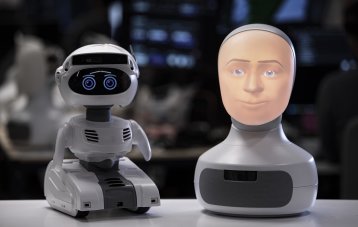 Social Robot Furhat
(Image: Furhat Robotics)
Social Robot Furhat
(Image: Furhat Robotics)
Furhat
Furhat is a social robot developed for Natural Language Processing. It speaks, listens, has a wide range of emotions and facial expressions, and can also maintain eye contact. The system supports multiple speech recognition systems with more than 40 languages and one of the world's largest collections of synthesized voices. Furhat has a number of powerful tools. For example, new faces and gestures, as well as eye and head movements, can be quickly created and implemented for Furhat. Furthermore, the system can capture expressive movements from users and respond accordingly with gestures and facial expressions as well as a change in voice.
Specifications:
- Dimension: 410 x 270 x 240 mm (HxWxD)
- Weight: 3.5 kg
- Degrees of freedom: 3
- Speech recognition and dialog function (> 40 languages; > 120 variants)
- Gestures/Mimic: 19 expressions
- Sensors: RGB camera, onboard microphone (2x), USB microphone (4x), RFID,
- Interface: Ethernet (TCP/IP), Wi-Fi IEEE 802.11 a/c, Bluetooth 4.2, USB
Application areas: Research, business-to-consumer
Research projects: SKILLED, Student research projects & third-party funded projects
Contact: Prof. Dr. Anja Richert, Ana Müller, Michael Schiffmann
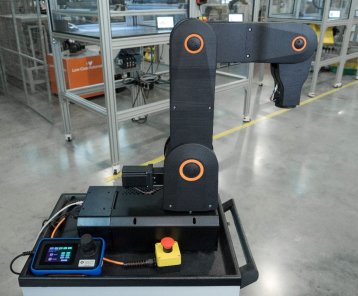 Igus Roboter
(Image: F09/TH Köln)
Igus Roboter
(Image: F09/TH Köln)
Igus Robolink D
Rotary axis with integrated motor for installation in industrial robots. The rotary axis is compatible with many stepper motors and the self-locking drives offer a high level of safety.
Specifications:
- Dimension: 360 x 160 mm
- Weight: 21.4 kg
- Repeatability: +/- 1 mm
- Payload: 500 g
- Degrees of freedom: 5
- Maximum range: 680 mm
- Interface: Ethernet (TCP/IP)
Application areas: Industrial robots, Pick&Place
Research projects: Student research projects & third-party funded projects
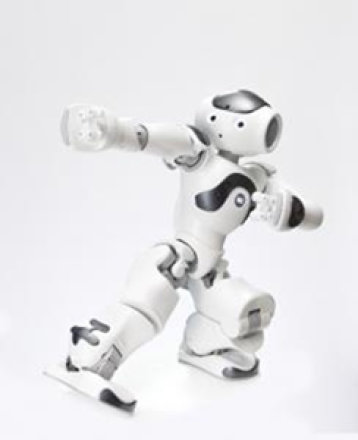 Nao: Humanoider, sozialer Roboter
(Image: doc.aldebaran.com)
Nao: Humanoider, sozialer Roboter
(Image: doc.aldebaran.com)
Nao: Humanoid, social robot
NAO is a humanoid social robot from Softbank Robotics. Designed for human-machine interaction, it recognizes faces, objects, and simple human emotions using its sensor technology. It can also walk, dance and converse with its counterpart in up to 21 languages.
Specifications:
- Dimension: 574 x 275 x 311 mm (HxWxD).
- Weight: 5.4 kg
- Degrees of freedom: 25
- Speech recognition and dialog function (up to 21 languages)
- Sensors: 2D camera (2x), 3-axis accelerometer, 3-axis gyrometer, force sensing resistor (8x), Hall sensor (36x), microphone (2x), sonar (4x), touch sensor (9x)
- Interface: Ethernet (TCP/IP), Wi-Fi IEEE 802.11 a/b/g/n, USB
Application areas: Learning, research, healthcare
Research Projects: Student research projects & third-party funded projects
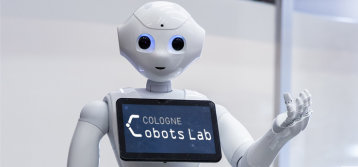 Humaniod Robot Pepper
(Image: Michael Bause/TH Köln)
Humaniod Robot Pepper
(Image: Michael Bause/TH Köln)
Pepper: Humanoid, social robot
Pepper is a humanoid, social robot. The robot can recognize faces and simple human emotions. You can have conversations with it as well as communicate through the front-mounted touchscreen.
Specifications:
- Dimension: 1208.5 x 477.2 x 424 (HxWxD).
- Weight: 29.1 kg
- Degrees of freedom: 20
- Voice recognition and dialog function (up to 15 languages)
- Sensors: 2D camera (4x), 3D camera, 3-axis accelerometer, 3-axis gyrometer, infrared sensor (2x), Hall sensor (27x), laser distance sensors (9x), microphone (4x), sonar (2x), touch sensor (5x)
- Interface: Ethernet (TCP/IP), WiFi (802.11a/b/g/n)
Application areas: Learning, research: business-to-business, business-to-consumer.
Research projects: SKILLED, GeneRobot, Student research projects & third-party funded projects
Contact: Prof. Dr. Anja Richert, Caterina Neef, Ana Müller
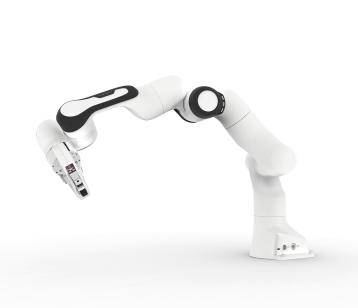 Panda
(Image: Franka Emika)
Panda
(Image: Franka Emika)
Panda: Collaborative lightweight robot
Panda is the collaborative lightweight robot from Franka Emika GmbH. The model has 7 axes, all equipped with force-torque sensors. The robot system can be programmed via a browser-based user interface.
Specifications:
- Weight: ~ 18 kg
- Repeatability: +/- 0.1 mm
- Payload: 3 kg
- Degrees of freedom: 7
- Gripper: Parallel
- Max. reach: 855 mm
- Interface: Ethernet (TCP/IP)
Application areas: Production, collaborative assembly
Research projects: QuKu-ML, Student research projects & third-party funded projects
Contact: Prof. Dr. Anja Richert, Nicolas Kaulen
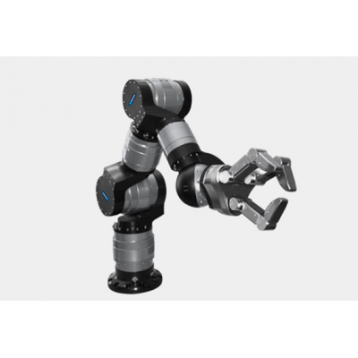 Roboterarm Schunk LWA 4D
(Image: Schunk)
Roboterarm Schunk LWA 4D
(Image: Schunk)
Schunk LWA 4D
The lightweight robot arm 4D can be combined with Schunk gripping systems. The high payload of 10 kg allows it to be used in Pick&Place applications.
Specifications:
- Weight: 18 kg
- Repeatability: +/- 0.15 mm
- Payload: 10 kg
- Degrees of freedom: 7
- Maximum range: 1113.4 mm
- Interface: CANopen (CiA DS402:IEC61800-7-201)
Application areas: Industrial robots, Pick&Place
Research projects: Student research projects & third-party funded projects
Contact: Prof. Dr. Anja Richert
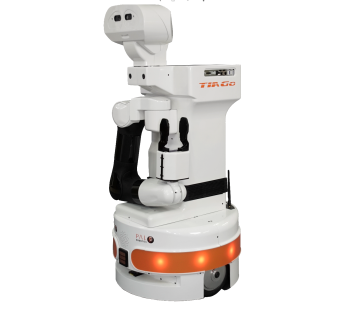 TIAGo
(Image: Pal robotics)
TIAGo
(Image: Pal robotics)
TIAGo (Steel): Mobile manipulator
TIAGo is a mobile manipulator from the Spanish company PAL Robotics. The model available in the CobotsLab has an arm equipped with a parallel gripper. This enables Pick&Place operations. With sensors for path planning and collision avoidance, TIAGo is suitable for navigation. Multilingual speech and text-to-speech recognition allow direct interaction with humans. Furthermore, the robotic system can recognize objects, faces and positions.
Specifications:
- Height: 1100 to 1450 mm
- Weight : 70 kg
- Footprint : ø 540 mm
- Degrees of freedom: 12
- Payload without gripper: 3 kg
- reach (without end effector): 870 mm
- Sensors: laser, inertial measurement units, RGB-D camera
- Interfaces WiFi 802.11 n/ac, Bluetooth 4.0
Application area: research
Research projects: Student research projects & third-party funded projects
Contact: Prof. Dr. Anja Richert
 YuMi
(Image: new.abb.com)
YuMi
(Image: new.abb.com)
YuMi IRB 14000: Industrial Collaborative Robot
YuMi is ABB's collaborative two-arm robot. Due to its design and safety concept, it is the world's first collaborative two-arm robot developed for small parts assembly. The model has two arms with seven axes each. Its repeatability of 0.02 mm is particularly noteworthy. YuMi is programmed using the RobotStudio programming and simulation software. YuMi is a subject of the master module Human-Machine Interaction. Here, content is programmed for collaborative work with the robot.
Specifications:
- Maximum working space: 1018 x 1328 x 1086 mm (HxWxD)
- Weight: 38 kg
- Repeatability: +/- 0.01 mm
- Handling capacity: 500 g
- Degrees of freedom: 14
- Interface: Ethernet (TCP/IP
- Safety standard: EN ISO 10218-1:2011
Research projects: MeRobot, MyRobot, Milki-PSY, Student research projects & third-party funded projects
Contact: Prof. Dr. Anja Richert, Tobias Keller
Additives & Tools
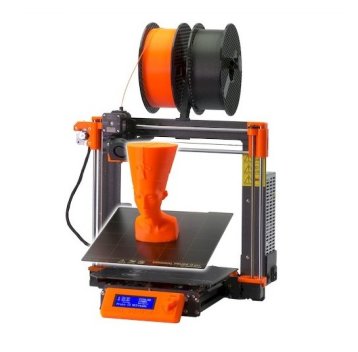 Original Prusa I3 Mk3s
(Image: Prusa)
Original Prusa I3 Mk3s
(Image: Prusa)
Additive Manufacturing (3D Printer)
3D printers for rapid prototyping. Using CAD data, the printers can produce prototypes and workpieces for design and research projects in a short time.
- Prusa i3 MK3S
- Ultimaker 2+ & 3
Materials that can be used: PLA, PETG, ASA, ABS, PC (polycarbonate), CPE, PVA/BVOH, PVB, HIPS, PP (polypropylene), flex, nGen, nylon, carbon filled, Woodfill and other filled materials
Contact: Prof. Dr. Anja Richert, Dario Luipers
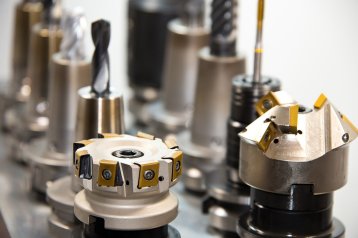 Werkzeug Symbolbild
(Image: blickpixel)
Werkzeug Symbolbild
(Image: blickpixel)
Tools
- Manual workstations (turning, milling, drilling), CNC milling machine
- Soldering workstations, SPS controls, access to central workshop of electrical engineering
- Access to the central workshop in the mechanical engineering department
Contact: Prof. Dr. Anja Richert, Prof. Dr. Ulf Müller
